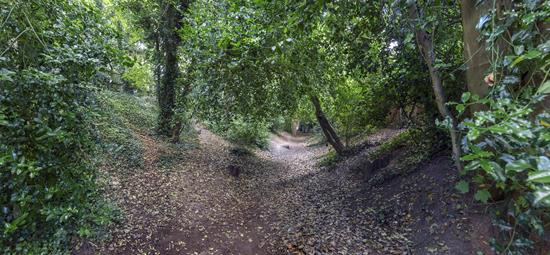The Iron Age begins in this area around 700 BC and marks the introduction of objects made of iron. Despite this significant technological change, there is considerable continuity between the Late Bronze Age and the Early Iron Age, with communities continuing to develop an agrarian lifestyle including the rearing of animals and the growing and harvesting of arable crops. Archaeological evidence from this period primarily takes the form of ditches (often land divisions) and pits.
Excavations at Staunch Farm, Wormingford revealed ditches which form part of an Early Iron Age field system. Likewise excavations at the Garrison in Colchester in 2004 revealed ditched field boundaries dating from the Early Iron Age and thought to represent part of a field system. A further field system laid out in the Early Iron Age was recorded at the Garrison in 2007. Two isolated Early Iron Age cremations and a possible Late Bronze Age or Early Iron Age round house were also found at the Garrison.
The Middle Iron Age is usually dated from around 350 BC and in Essex there appears to be an expansion in the population, as settlement evidence becomes more evident and roundhouses are frequently recorded during excavations. At the Garrison in Colchester, excavations revealed traces of a Middle Iron Age enclosure and associated features including a roundhouse. Craft activities appear to flourish during this period, with loomweights being recovered from sites within Colchester such as the Garrison, and further afield.
The Late Iron Age is a period of significant change which sees the emergence of tribal groupings and the forging much closer links with the continent. This period also sees the growth for the first time of early towns known as oppida which functioned as political and commercial centres. The influence of the Roman world can be seen in many aspects of material culture, particularly amongst local elites where their desire to adopt Roman customs drives trade between Britain and the continent. Links with the Roman world are clearly visible in the archaeological record as new types of pottery vessel such as amphorae (used to transport wine and other liquids), and Roman ceramic tableware and glass start to appear.
Other evidence for Roman influence comes from the graves of wealthy individuals who died during this period. Perhaps the most obvious example of this is the richly furnished burial inside the Lexden Tumulus which was excavated in the 1920s. The grave was found to contain the cremated remains of an adult male and buried alongside him was a rich assemblage of grave goods including chain mail, a folding stool, a Middle Bronze Age copper alloy axe head wrapped in cloth, rare figurines, 17 amphorae and a silver medallion of Augustus. One possibility is that this is the grave of Addedomarus, one of the kings of Camolodunum. Likewise, the grave of the so-called Kelvedon warrior, buried sometime between 75 BC and 25BC, was found to contain an iron sword that had been wrapped in linen and bent at the funeral, a bronze scabbard decorated with a strip of applied tin, an iron shield boss, and an iron spear blade, a tankard with copper-alloy fittings and a bronze bowl from the Roman world. At Stanway, excavations in advance of gravel extraction revealed the burial place of a high-status Catuvellaunian family. This site features richly furnished burials, chambers and mortuary enclosures. One burial has been termed the 'doctor's burial' as it contained medical implements and rods as well as a gaming board.
 The development of Colchester as a regional centre has its origins in the Late Iron Age. During this period the settlement known as Camulodunun (later Latinised as Camolodunum) became the tribal capital for the Trinovantes, and coins minted by the tribal leader Tasciovanus bearing the inscription 'CAM' start to appear sometime between 25 BC and 15 BC. Coins minted by Tasciovanus' son Cunobelin are known from at least 25 sites in and around Colchester.
The development of Colchester as a regional centre has its origins in the Late Iron Age. During this period the settlement known as Camulodunun (later Latinised as Camolodunum) became the tribal capital for the Trinovantes, and coins minted by the tribal leader Tasciovanus bearing the inscription 'CAM' start to appear sometime between 25 BC and 15 BC. Coins minted by Tasciovanus' son Cunobelin are known from at least 25 sites in and around Colchester.
A system of dykes was developed around the settlement at this time, presumably as a defensive measure. Several stretches of the Colchester Dykes are still accessible today including Lexden Triple Dyke and Blue Bottle Grove, both of which are well-preserved examples from the Late Iron Age.